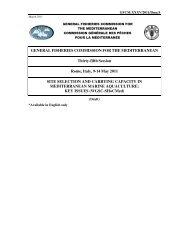English
English
English
Create successful ePaper yourself
Turn your PDF publications into a flip-book with our unique Google optimized e-Paper software.
41<br />
GFCM:SAC13/2011/Dma2<br />
belongs to viviparous fish; fingerlings are born at temperature more than 15°C. It distributes<br />
with maximum density in Kalamitsky and Karkinitsky Bays in depth of 5 -30 m.<br />
Grounds and fishing gears for target fishing of Rajiformes are the same as for picked dogfish.<br />
By-catch of Rajiformes in trawls is inconsiderable and usually it releases to sea completely as<br />
these fishes are of little demand at the domestic market. Till the early 1990s totally the whole<br />
yield of Rajiformes were processed into the minced meat for feeding of poultry and other<br />
domestic animals. After 1992 sales of minced flesh as feeds for animals slumped and<br />
fishermen lost their interest for harvesting of Rajiformes. For recent years in Ukraine there<br />
has been observed people's demand for Rajiformes as human food. In this connection their<br />
fishing becomes to revive.<br />
Till 1993, when the intensity of Rajiformes fisheries was high in the waters of Ukraine and<br />
catches of thornback ray varied within the range 0.3-0.6 thousand tons, the stock of this<br />
species was assessed by VPA method applying the software ANACO produced by FAO<br />
(Shlyakhov, 1997; Shlyakhov and Lushnikov, 1995). For the subsequent years the intensity of<br />
the coastal fisheries became so low that application of this method was incorrect. For some<br />
years the stock of thornback ray was assessed by the trawl surveys data, however, due to the<br />
under-recording of fishes in small depths these assessments were underestimated (Table 9).<br />
Table 9: Commercial stock (thousand tons) of thornback ray in the Ukrainian Black Sea in<br />
1992 1998.<br />
Years<br />
stock<br />
VPA Trawl Survey<br />
1992 2.6 1.1<br />
1993 - -<br />
1994 - 0.9<br />
1995 - -<br />
1996 - -<br />
1997 - -<br />
1998 - 1.0<br />
Russia<br />
Some data on the biology of dogfish and stingrays are given. All these fish have secondary<br />
commercial importance because their annual catches are not big.<br />
The dogfish squalus acanthias Linnaeus, 1758 is a small shark (it is up to 2 m long, weight is<br />
up to 18 kg), inhabits the whole water column but prefers lower layers. Its main food items<br />
are anchovy, kilka and other small fish, especially those which form accumulations. Its annual<br />
catch has decreased during last decades, but they do not reflect the state of the stock. The<br />
scientific trawl surveys undertaken every year show that the biomass of the dogfish in the<br />
north-eastern part of the Black Sea is near 20 th.t and the total admissible catch (TAC) can be<br />
estimated as 700 tons.<br />
Rays. There are two species (the thornback ray Raja clavata Linnaeus 1758 and the stingray<br />
Dasyatis pactinaka Linnaeus, 1758) in the Russian part of the Black Sea. They occupy<br />
different ecological niches. Their stocks are about 800 t. Rays are usually caught together<br />
with dogfish and flounders. TAC for ray cannot be more than 100 t.
















